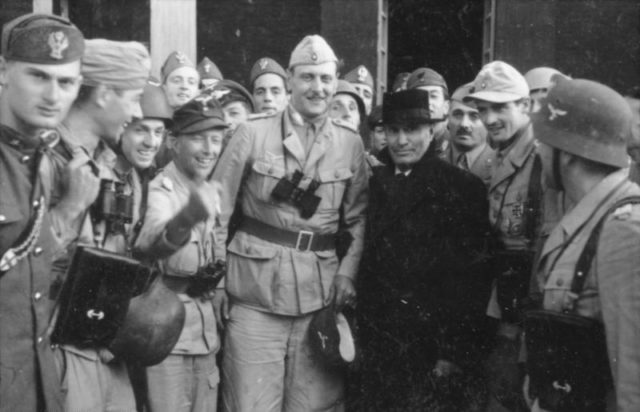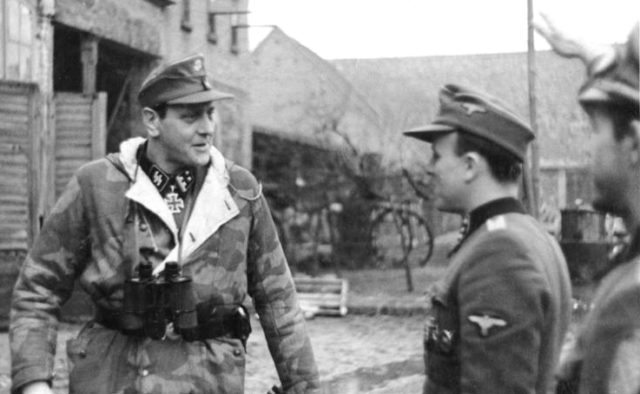No one passing his white Mercedes when driving along the bucolic roads around the Curragh in Ireland’s County Kildare in the late 1950s would ever have thought it was being driven by one of Hitler’s most trusted troubleshooters. But he didn’t look like many other Irish farmers either. This surly gentleman, sporting a scar across his face, was none other than Otto “Scarface” Skorzeny. Known during World War II as the Third Reich’s Scarlet Pimpernel, the six foot four inch tall, 250-pound SS Commander was not a man that you could miss.
Skorzeny was born in Vienna on June 12, 1908, to a middle-class Austrian family with Polish ancestors. He was raised and educated in Vienna, and he spoke not only German but fluent French and pretty good English. He studied civil engineering at University, and was a proficient fencer–he took part in 15 duels, the tenth of which accounted for the dramatic scar on his face.
Skorzeny was a charismatic character, and he joined the Austrian Nazi Party in 1930, where he made many friends. When Germany invaded Poland in 1939, he volunteered to join the Luftwaffe, but he was rejected as he was too old (at 31) and too big. He was accepted as an officer-cadet in Hitler’s personal guard regiment, the Leibstandarte SS Adolf Hitler (LSSAH).

Skorzeny served on the Eastern Front but was injured by shrapnel in December 1942. He was sent back to Berlin for treatment and recuperation; this is where he worked on his ideas for unconventional warfare. He proposed taking teams of men and training them to fight far behind enemy lines, causing havoc as they destroyed essential installations, both military and civilian. The first attempt at this form of warfare was tried in Iran, but it failed due to the intransigent nature of the hill tribes that the Germans had sought out to incite to rebellion. The unit did have some success behind Russian lines, but shortages of supplies, equipment, and planes to drop the insurgents made the roll-out extremely slow.

In July 1943, Hitler personally selected Skorzeny to rescue Benito Mussolini after he had been imprisoned during the overthrow of his government. The Italians frustrated initial attempts to rescue Mussolini; they moved him on a regular basis to thwart any rescue attempts. But on September 12, 1943, Skorzeny personally led the raid by drifting his team onto the Gran Sasso mountaintop in gliders and landing at the Campo Imperatore Hotel where Mussolini was being held.
Mussolini was rescued without a shot being fired, and he was escorted to Rome and then on to Berlin. Skorzeny was promoted to the rank of Sturmbannführer (Major) and was awarded the Knight’s Cross of the Iron Cross. This successful raid enhanced his standing with Hitler, and the audacious nature of the raid made international headlines. Even Winston Churchill was impressed, saying that the raid was one of great daring.
Skorzeny took part in or planned several other challenging operations during the war, including an unsuccessful attempt to assassinate Churchill, Stalin, and Roosevelt at the Tehran Conference in 1943. His last operation was during the Battle of the Bulge in late 1944 when he and his English-speaking troops infiltrated Allied lines disguised in American uniforms and driving captured American Jeeps. The Allies captured a few of his men, who spread a rumor that Skorzeny intended to lead a raid on Paris to assassinate General Eisenhower, forcing Eisenhower to spend Christmas of 1944 isolated for security reasons. Eisenhower then put up “Wanted” posters, with a detailed description of Skorzeny, all over the territory controlled by the Allies. Most of the German soldiers that took part in this operation were captured, and many were shot as spies for wearing American uniforms.

Skorzeny spent the last months of the war leading regular troops as an acting Major-General in East Prussia. Before the war ended, he was awarded the Nazi’s highest award–oak leaves for his Knight’s Cross.
Skorzeny was tried as part of the Dachau War Crimes trials for allowing his men to wear American uniforms. He argued that wearing the uniforms was not an issue provided they discarded them before engaging in a battle. After British SOE agents gave evidence that they wore German uniforms during the war, the case against Skorzeny was dismissed. Skorzeny was retained in prison since he was facing other charges from different countries, but in typical Skorzeny fashion, he escaped. Three SS colleagues, dressed in American uniforms, escorted him out of the camp, claiming they were taking him for a hearing.
He traveled for a time and eventually ended up in Madrid, where he set up a small engineering and import/export business. A great deal of his business was legitimate, but rumors persisted that he used the business to facilitate the escape of Nazis from Germany to Argentina and other countries. He did travel to Argentina on several occasions and at one time saved the life of Eva Peron, wife of the Argentine president.
In mid-1957, he was invited to the Portmarnock Country Club hotel in County Dublin in Ireland. He was warmly received and feted by the cream of Irish society, which included many young politicians such as Charles Haughey, who went on to become Ireland’s controversial prime minister. His warm welcome in Ireland encouraged Skorzeny to buy Martinstown House, a 160-acre farm and country house in the Curragh, County Kildare.

Skorzeny was traveling on a Nansen passport (for stateless persons), so Ireland could not refuse him entry. His presence in Ireland did concern the Irish government, and they refused him a permanent resident visa, so each visit was limited to six weeks. As well, he was not permitted entry into England–a circumstance that that inflamed Skorzeny’s anger on several occasions.
The possibility of Nazism again rising in Europe was a real fear after the war, and Skorzeny’s presence in Ireland concerned many politicians. The authorities feared that Skorzeny was acting as a conduit for Nazi escapees. Noel Browne, the Irish Health Minister at the time, feared that he would use Ireland for that purpose. This claim was never validated, but the ongoing fear of the rebirth of the Nazi regime and the hatred of the SS fueled calls for Skorzeny to be refused residence. Skorzeny refuted all claims that he was helping Nazi fugitives and insisted that all he wanted to do was buy some horses and live peaceably on his farm. This was never to occur, and eventually, Skorzeny stopped visiting Ireland. He sold the property in 1971.

Skorzeny’s last company was the Paladin Group, based in Spain. This company trained troops for guerrilla warfare and counted many governments among its clients. Skorzeny died of lung cancer at age 67 on July 5, 1975, in Spain. His coffin was draped with Nazi colors, and his funeral was attended by many of his Nazi comrades; he was given a Roman Catholic burial in Madrid. He was a committed Nazi to the end and refused to denounce anything done during the war years.

Skorzeny was not the only high-profile Nazi to have resurfaced in Ireland after the war. Men such as Albert Folens and Helmut Clissmann made new lives in the country. Cathal O’Shannon, in a 2007 Irish television documentary Hidden History: Ireland’s Nazis, said that an estimated 100 to 200 Nazis made their way to Ireland and were incorporated into Irish life. The documentary makers believed that anti-British sentiment accounted for the warm welcome that many Nazis received, a warmer welcome than many Irish soldiers received when they returned from WWII. Many Irish nationalists subscribed to the notion that “my enemy’s enemy is my friend” and it was not until the 1990s, when public consciousness was pricked with issues surrounding the Holocaust, that public opinion started to change.
Read another story from us: Swimming in searchlights: The cathedral of light of the Nazi rallies
It hardly seems likely that a man of Skorzeny’s stature and daredevil nature could have been quietly living and raising horses in a rural Irish environment. The fact that he went on to found a company that trained guerrilla fighters seem to belie the possibility that he would have been able to live as a farmer and fit nicely into the pastoral life of the Irish countryside.
